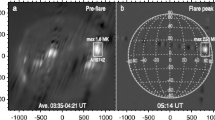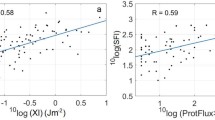Abstract
Solar circumstances have been evaluated for January 28, 1967, the date of an observed ground level enhancement of cosmic rays which was not preceded by observation of a suitably great Hα flare. On the visible solar hemisphere, a bright subflare at S23° E19° occurred in appropriate time association with the cosmic ray event, and was accompanied by weak X-ray enhancement and radio frequency emission. If this flare, alone, or in combination with other minor flares observed on the visible hemisphere on January 28 was the source of the energetic cosmic rays recorded on that date, then current thinking regarding the characteristics of cosmic ray flares must be modified.
An initial study of probable circumstances on the invisible hemisphere did not lead to the immediate recognition of amajor center of activity as the probable source of a cosmic ray flare. Further evaluation of all centers of activity on the invisible hemisphere identified one region, McMath Plage No. 8687, 64° beyond the west limb, as the most plausible, possible site for the cosmic ray flare on January 28, 1967. The location of this region is in accord with the source-position deduced in Lockwood's analysis (1968) of the cosmic ray event. This center of activity could not have been more than 5 days old on January 28, 1967. The interval of major activity in the region was confined primarily to the invisible hemisphere. The occurrence of an ‘isolated’ major flare in the region on February 13, 1967 is discussed. The present study exemplifies the partial nature of solar observations which are limited to the visible hemisphere.
The possible role of exceptional geomagnetic calm, 1963–1967, in permitting atypical cosmic ray enhancements, as on January 28, 1967, is mentioned.
Similar content being viewed by others
References
Castelli, J. P. and Aarons, J.: 1967,J. Geophys. Res. 72, 5491.
Crary, J. H. and Diede, A. H.: 1969,J. Geophys. Res. 74, 362.
Dodson, H. W. and Hedeman, E. R.: 1968, ‘Some Patterns in the Development of Centers of Solar Activity, 1962–66’,Report of IAU Symposium No. 35,56.
Dodson, H. W. and Hedeman, E. R.: 1969,Annals of IQSY 3, 215.
Lockwood, J. A.: 1968,J. Geophys. Res. 73, 4247.
Masley, A. J. and Goedeke, A. D.: 1968,Can. J. Phys. 46, 766.
Solar-Geophysical Bulletins (ESSA, Boulder, Colo.) IER-FB 270, 271 and 278.
Wild, J. P., Sheridan, K. V., and Kai, K.: 1968,Nature 218, 536.
Author information
Authors and Affiliations
Rights and permissions
About this article
Cite this article
Dodson, H.W., Hedeman, E.R. Solar circumstances at the time of the cosmic ray increase on January 28, 1967. Sol Phys 9, 278–295 (1969). https://doi.org/10.1007/BF02391649
Received:
Issue Date:
DOI: https://doi.org/10.1007/BF02391649




